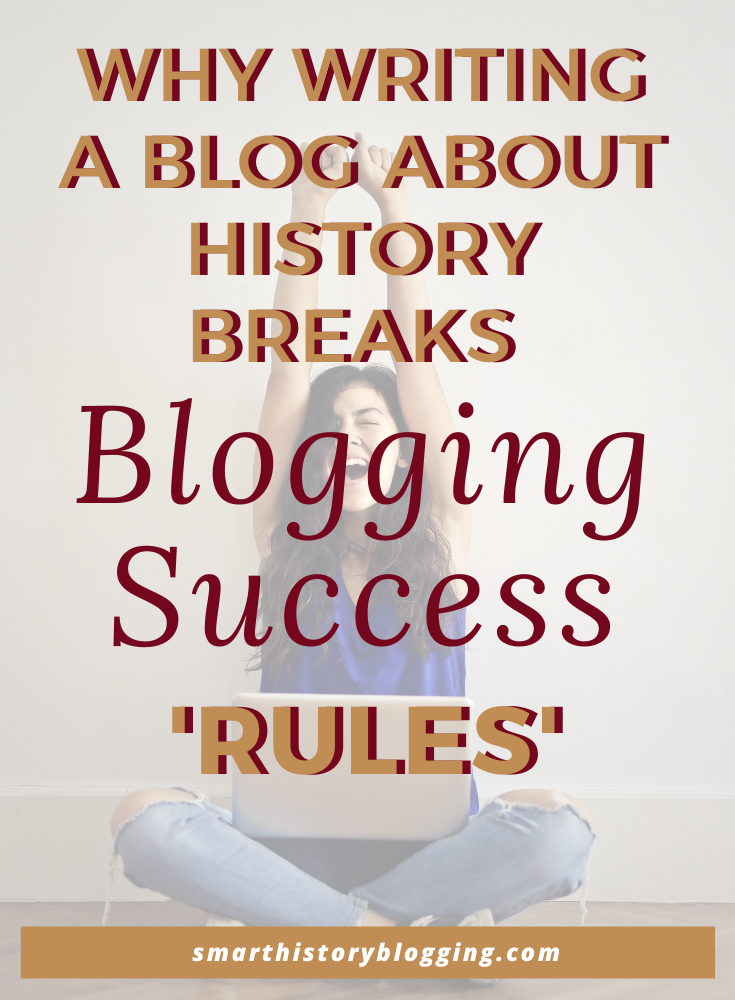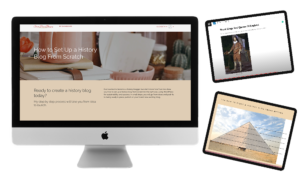History is littered with figures that sat on the fringes of what everyone else was doing and thinking in their field. Figures like Pythagoras, Charles Darwin, Winston Churchill in the 1930s, Abraham Lincoln and Aristotle. In my experience, I believe writing a blog about history is often on the fringes in the field of blogging.
Hear me out…
Scarcity of resources will never be an issue for today’s blogger. There are over 1 billion entries if you just Google ‘growing a blog.’ But, the not-so-good news is within that billion you can waste a heck of a lot of time digesting blogging rules that are too focused on problem-solving, to sales first, blog second and where the blog is just an add-on to make money. That’s so not us! Many times I’ve read the advice and thought “but how can I apply that to my blog” It left me confused, my mojo crushed.
Then I changed my thinking and approach, telling myself growing a history blog doesn’t have to follow all the ‘rules’ and it’s ok to bend and even break a few.
Let’s help you navigate all that blogging advice…
So, here I want to do three things to help you start to navigate all the blogging advice out there and grow your blog true to the amazing history blogger you are:
- Explain the principles where history blogging can follow the rules
- Show you where growing and writing a history blog breaks the rules
- Give you five steps to re-write the rules and apply them to growing and monetizing your history blog.
Here we go…
Where Writing a Blog about History Follows the Blogging Rules
Now there are many areas, tasks and principles where we’re exactly the same as mainstream bloggers. Here are some examples:
- Setting goals for our blog
- Creating an easy to say, spell and use blog name and URL
- Building an accessible blog site with branded design, good layout and easy navigation
- Writing a blog which contains lots of well-written posts of around 1500+ words
- Producing a range of structured posts consistently
- Using keywords and other tips and tricks to optimized every post for search engines
- Finding eye-catching high-quality images
- Using social media to promote your posts
- Nurturing an email list to talk directly to people really interested in our content.
Related link: If you want to know more about keywords visit my post “Are these 7 Keywords Research Mistakes Holding Back Your History Blog”
Where Writing a Blog about History Breaks the Popular Rules
Chances are you’re already doing many of the things listed above and producing great posts. But, I believe where history blogging differs to mainstream is applying the methods to grow and monetize.
If you want to increase your reach, get more traffic and maybe start to make some money from your history blog then sooner or later you’ll search to learn new skills. You’ll delve into hundreds of blogging courses, webinars, websites and podcasts. Now, it’s here where the blogging rules that don’t fit being a history blogger can potentially overwhelm you.
If your history blog is information-based only, let’s say about Queen Victoria, Marie Antoinette or Scottish History, here are some of the blogging ‘success’ rules, which may have left you confused:
- Every blog post has to solve a problem or show someone how to do something
- All blog post titles need a results-based headline
- You need to position yourself as an expert in helping people
- All opt-ins need to be checklists or step-by-step guides or your email list will not grow.
- The services and products you offer must align with the problems you’re solving.
For me, it’s more than about being in a niche blogging area. Many history blogs are solely about sharing information and historical interests not business problem solving. In addition, the actual blog is often the starting point from which everything else grows, not a supporting add-on.
They are not, for example, a company who sells Union Jack teapots (yes, I have one : ) and has a blog on their site about the history of tea. (oooh, that must exist somewhere!)
Now, I am not saying these rules are wrong. They’re designed to help you improve your SEO, get more traffic, get more loyal visitors onto an email sign-up and produce services or products those visitors want to buy. What I’m saying is they can be presented far too corporately for a history blogger and I’m here to help you find a way through it to grow your blog.
How You Can Re-write The Rules When Writing a Blog about History.
Before casting your eye over step one, in broad terms you must know what you want from your blog. What’s the ultimate, punch-the-air and shout “I did it” goal?
Is it one of these?
- Writing a blog makes me happy. It’s the fun sociable hobby I wanted
- It’s a fun hobby and I can cover my costs
- I used my blog as a base and became a social media influencer or YouTuber
- I used my blog to grow my email list and get into affiliate marketing recommending the products I like and use
- I used my blog as a base to offer my own products and services like books and courses.
If you fall into the latter part of the list then you must start thinking of your blog as a business with target audiences, buyers and revenue streams. This isn’t to crush your creativity or fun but to give it focus and allow you to see where changes may need to be made.
Related Link: If you need help setting your goals read The Secrets to Setting Blogging Goals
Rewriting The Blogging Rules in Five Steps
Step 1: Look at What’s Hot and What’s Not?
Looking at your goals (because I know you did that part : ) ask yourself a series of questions to evaluate what is working and what is not:
- What is currently working or not working to reach your goals?
- Is it time to look at your business model and marketing strategy?
- Which social media platform brings people to your site?
- Are you using enough variety of media like video and audio?
- Do the banner ads or affiliate marketing partners you have work for you?
- Do people click through?
- Is anyone on your email list or signing up via RSS.
- Are they buying anything?
- Are you making any money?
- Are your traffic numbers where you want them to be for the effort you put in?
- What at the back of your mind do you think you should be doing or stopping?
Take Action: Honestly assess your blog, analytics, income streams and social media and marketing practices.
Step 2: Know whom your writing a blog for and attract visitors to it.
The best piece of marketing advice I’ve ever heard is “attract the customers you want and repel the ones you don’t want” In other words, are you being super clear who your blog is for so when they arrive on your blog they say “hell yeah, this is the place for me!”
For example, I started Smart History Blogging because I was trying to cram blogging advice into my first site Britpolitics, where I offer resources for people studying history. And, it just didn’t work. If you clicked on Britpolitics as a history student you’d wonder why on earth I was writing about social media marketing and if you were a history blogger you weren’t interested in reading about history exam revision techniques.
To find out whom you’re currently attracting look at your web analytics and social media ones. What type of person is following you or clicking through? Based on the goals for your blog, if you’re attracting the wrong kind of people you may need to look at your niche.
Then, I encourage you to take the action below. Why? Because if you’re super clear about attracting the right people to your site you can build activities and revenue streams around them that will work : )
Take Action: Create a profile for your ideal visitor
The jargon here is creating an ‘avatar.’ Focus in on a person and build-up a profile. What are they like? What do they want out of life? What do they read? Where do they hangout online? What do they spend their money on? How much money do they have?
Want to know mine?
For Smart History Blogging my avatar is an enthusiastic but frustrated history lover who has work, study and busy life but wants to know from my blog, products or services the quickest ways to start or grow a history blog. They also, like me, love historical films, books, locations, exhibitions, events and sharing thoughts about history on social media.
Step 3: Map out how you can scale your history blog
The good news is, if you find the right audience, there are revenue possibilities from writing a blog about history and you should always look to have multiple streams of income.
But, there are several pitfalls within a niche like history blogging:
- General Banner ads – I have them, but without stacks and stacks of traffic these can sometimes look tacky and aren’t worth it.
- Advertising revenue from Youtube – If video is your focus then go for it but again, you need a lot of traffic and will probably need to combine it with affiliate marketing
- Affiliate marketing – done right this can be a winner but the mistake is to focus on low cost items like books and dvds where the commissions can be small. Really think about bigger ticket items you could naturally talk about and promote
- Waiting – You don’t need to have millions of visitors to start putting a revenue strategy in place that may make money. If you have an online course pitched at the entire world for £20, you only need FIVE people to see it and like it to make £100.
An example of scaling a history blog
If you’ve followed the first two steps this should be a lot easier. Using my Scottish History example (and apologies for any clichés here), it may look something like this:
- I’ve narrowed my blog about Scottish history to focus in on locations so I produce great SEO rich content to attract people who want to visit Scotland, have visited, once lived there, have ancestry ties and like looking at images of Scottish lochs, landscapes and castles.
- My affiliate schemes are with partners and products I use when visiting historic sites in Scotland. They include discounts on ticket entries, accommodation, walking equipment and cameras. I’m solving the ‘problem’ of where to stay? What to wear? Where to visit first? What camera to buy for the misty Scottish weather?
- I talk about these products and partners on a variety of social media platforms, as well as general posts about the great book about Robert the Bruce I’ve just read.
- I create a free product like an e-book, to collect email addresses, related to Scottish history, with a little summat extra than my blog!
- I produce a digital course on how to track your Scottish ancestry
- I create a physical product related to historic Scotland locations, maybe a waterproof guide, a diary or calendar using images I have taken already.
- I become the go-to person for a Scottish history lover!
Take Action: Create your own map showing how you will naturally scale your history blog within your chosen niche. Keep is simple but ambitious! No thinking small allowed.
Step 4: When people find your blog what do you want them to do?
In steps 1-3 you’ve set your goal, honestly evaluated your existing blog, decided whom you want to attract and devised a plan for scaling your blog. Now, you need to make sure your actual blog and the content you produce are not working against you!
There are multiple points of entry to your blog. These could be:
- Your blog homepage.
- A blog post on your site or guesting on someone else’s.
- The about page.
- Your contact page.
- Your IG, Twitter or Facebook feed or a single IG post.
- Through Youtube or Pinterest.
No matter how someone finds you the messaging about what you want someone to do next needs to be uncluttered and clear, not overwhelming. Maybe your drive is to get people to share your content – make sure you’re (creatively) asking people to do that everywhere.
This also applies to your blog design. Does the layout allow people to easily find the offer to that free e-book? Does your menu make sense for navigation? Could you make use of pop-ups to capture peoples interest as they scroll?
Take Action: Revise (or start) your editorial calendar with your goal in mind. Does all activity, in a variety of ways, encourage people to go down the direction you want.
Step 5: Focus your efforts and be realistic about time
As someone who suffers from ‘shiny object syndrome’ I constantly tell myself this.
I may want it all, I may be able to have it all but I can’t have it all, all of the time.
We’re constantly being told blogging advice that can quickly become overwhelming. Blog daily, pin 30 times a day, do a live video at least twice a week. Although there are clear merits for being on every platform frequently if you’re stretched for time focus in on doing a few things really well rather than lots of things kinda meh! But, always make sure every activity will drive your history blog forward.
You may need to be realistic about how long scaling your blog could take. For example, some SEO changes can take 3-5 months to give higher traffic results. Try not to get distracted by the next shiny object while you’re waiting.
Take Action: Look at your editorial calendar again and make sure it’s not too much of a stretch for your time.
Conclusion
In this post, I really wanted to show that you’re not alone when you listen to blogging success rules and feel it doesn’t quite fit what you’re doing. But, equally, with a few bends and breaks of those rules, you can grow and make money if you want to from your history blog. As ever, I’d love to know what you think and if you feel, like me, history blogging breaks the blogging success rules. Drop me a line in the comments or get in touch.
Until next time. Happy history blogging.
Elizabeth





